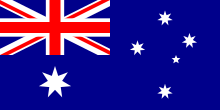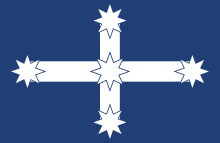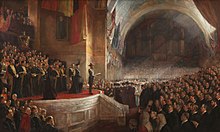History of australia
The history of Australia encompasses developments in the area of what is now the state of Australia from prehistory to the present.
History of the indigenous people
The ancestors of today's Aboriginal people lived on the continent for at least 50,000 years . Genetic studies also suggest a settlement around 50,000 years ago. A few researchers also lead the megafauna to become extinct around 13,000 BC. Chr. Back to human influence. Australia has been isolated from the Asian mainland since the Late Cretaceous Period (approx. 70 million years) , also in the pleniglacial (approx. 18,000 BC), when the sea level was 130 m lower than today, although Australia was with New Guinea and some other islands connected to the Sahul continent, but there was no land bridge to Sunda .
The oldest human remains in Australia are those of Mungo Man and Mungo Lady , both dated around 40,000 years ago and found in Mungo National Park , New South Wales . Artifacts of the same age are known from other sites . At around 8,000 years, the so-called keilor skull , which was discovered in 1940, is much younger .
In 2005, 457 human footprints from the last Ice Age were discovered in Mungo National Park. The tracks were created 19,000 to 23,000 years ago in the moist clay soil at Lake Willandra .
At Lake Condah , southwest of Mount Eccles National Park , remains of old stone buildings were found in the 1990s.
Despite the isolated location of the continent, the Aborigines were in contact with other cultures. Until the land bridge to New Guinea was flooded about 6000 years ago, there was an almost unhindered cultural exchange between New Guinea and northern Australia. After the newly formed islands of the Torres Strait were settled by Melanesian seafarers about 1000 years ago , there was renewed interactions with residents of northern Australia. Also Chinese and Indian traders as well as Indonesian fishermen probably visited the Australian coasts for several centuries. The cultural influence of these visitors is evident in many of the Aboriginal rock and bark paintings . Another testimony to this trade relationship is the dingo , which was probably introduced by Southeast Asian sailors around 6000 years ago.
Marco Polo's reports from Australia
A continent in the south was already suspected in antiquity. The term Terra australis incognita , which was later translated into Latin, was coined by Claudius Ptolemy for the unknown southern region. In 1292 Marco Polo sailed from China back to Venice and reported about a country that was full of gold and shells and was located south of Java . He called it Greater Java (Jave la Grande). There were also reports that the Chinese were already familiar with this southern country. A Chinese emperor is said to have owned an animal that had only two legs and the head of a deer. However, it had a second head on its stomach. This description is very reminiscent of a kangaroo with a young animal in a pouch.
The first landings of Europeans
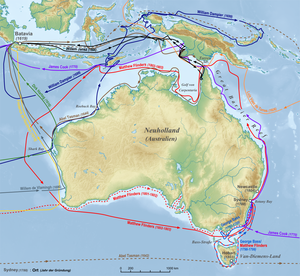
A more than 600 year old coin from the African Kilwa , which was found on the Wessel Islands , suggests that Portuguese seafarers reached the Australian coast as early as the beginning of the 16th century. The Portuguese had conquered Kilwa in 1505. In 1515 they landed for the first time on the opposite Timor .
Spanish sailors reached the coasts and went ashore in the 16th and 17th centuries. The map of the world, which Jean Rotz from Dieppe, France, made in 1542 for the English, shows Marco Polo's Greater Java ( The Lande of Java ) . This is similar to today's map of Australia and shows, for example, the Cape York Peninsula in the northeast.
Discoveries and expeditions by the Dutch:
In 1606, probably in March, Willem Jansz landed on the northern tip of what is now Queensland . Other Dutch (above all Dirk Hartog ) reached Australia between 1616 and 1640. For example, the Dutch East India Company's merchant ship Batavia ran aground on the west coast in June 1629 , but its commander François Pelsaert did not consider the discovery to be of decisive importance.
It was not until 1642 that the Dutch East India Company decided to explore the continent with a planned expedition. This led to the discovery of Tasmania by Abel Tasman . Another expedition, which began in 1696 under Willem de Vlamingh , mapped parts of the west coast of Australia. The Dutch, however, had no interest in colonizing Australia.
Colonization
On April 28, 1770, Captain James Cook reached the east coast of Australia and took the land as New South Wales for the British Crown. The purpose of his trip was to find the so-called Terra Australis , which, according to a theory common at the time, had to be present as a counterweight to the land masses in the north of the globe.
After the US became independent from Britain, the British government looked for new ways to establish colonies for their convicts . On January 26, 1788, therefore, the first eleven ships of the First Fleet ("First Fleet") with around 1000 women and men, including a good three quarters of convicts, arrived in Port Jackson under the leadership of Arthur Phillip . The new settlement was named Sydney in honor of the British Interior Minister at the time, Lord Sydney . At first, the colony found it difficult to support itself, which is why trade with the resident Aborigines such as Darug and Eora was carried out. A captured Aboriginal, Bennelong , served as an intermediary. Diseases were brought in with the prisoners; In 1789 more than 50% of the Darug died from a smallpox epidemic . The spread of settlers on the continent led to increasing conflicts with the Aborigines over access to land and food sources.
A total of around 162,000 convicts were brought to Australia. It was not until 1868 that the deportation of convicts was completely abandoned.
New colonies emerge in Australia
In 1792 a French expedition landed in Tasmania to explore the country. The British then decided to set up a colony here as quickly as possible. In 1803 they built Risdon Cove on the Derwent River , a year later Hobart Town , also on the Derwent, and George Town on the Tamar River . In 1825 what was then Van Diemens Land was declared an independent colony.
In 1788 the first convict colony was established in New South Wales . In 1824 a new penal colony was established in the mouth of the Brisbane River . The remoteness of this location should increase the security of the colony. However, after free settlers increasingly pushed to the fertile pastures of the north, the colony released the land for settlement in 1842. In 1859 Queensland was proclaimed a colony independent from New South Wales.
In 1835, Tasmanian businessmen dealt with the Aborigine Billibellary with Batman's Treaty of 2,400 km² in the area of what is now Melbourne and founded Port Phillip . Although this trade was considered illegal because it contradicted the concept of Terra Nullius , i.e. the concept that the land does not belong to anyone, the colony leadership gave in to the pressure of the growing population and had to officially open the land for settlement. In 1851 the new colony Victoria officially separated from New South Wales.
The colony of New South Wales initially occupied the entire eastern part of the continent, only the western third remained unclaimed by the British as New Holland. To prevent the threat of French colonization of Western Australia, the British established a settlement here, Albany , in 1826 . The colony of Western Australia was proclaimed in 1829 with the establishment of Perth . Although no convicts were originally to be sent here, in 1850 the free settlers demanded that this practice be abolished in order to equip the new colony with cheap labor.
Even South Australia should arise as a convict free colony. In the course of "systematic colonization" according to plans by Edward Gibbon Wakefield , land was sold and the proceeds used to bring free settlers to the colony. In 1836 Adelaide was founded and in the same year South Australia was named as the province of Great Britain.
At the same time the number of conflicts between settlers and Aborigines increased; and there was a wave of massacres . From the middle of the 19th century, the Aborigines were therefore assigned protectorates in which they were supposed to practice agriculture and animal husbandry in permanent settlements. The protectorates were administered by Chief Protectors , who had extensive rights, for example they could decide on the whereabouts of the children. From the beginning of the 20th century and into the 1970s, children with white parents in particular were forcibly removed in order to assimilate them in missions and homes. The National Sorry Day reminds us of these stolen generations .
Course of the exploration of Australia
Mapping of the coast continued into the 19th century. 1801–1803 Matthew Flinders was the first to circumnavigate the entire continent.
During the colonial period, numerous expeditions made the hinterland accessible and explored for further settlement. For many years, expansion of the colony westward was prevented by the impassable Great Dividing Range . Regardless of this, Gregory Blaxland led an expedition over the Blue Mountains in 1813 , which paved the way for further small expeditions inland.
In 1824, Hamilton Hume and William Hovell found a way from New South Wales to Victoria to Port Phillip for the first time on their expedition , which took place on the proposal of Governor Thomas Brisbane . This enabled settlement of the hinterland and in the course of this expedition they discovered the rivers Murray and Murrumbidgee .
Charles Sturt's expedition to the Murray Estuary from 1829 to 1830 opened up southern Australia for further settlement. It also showed that, contrary to earlier assumptions, the major rivers of the Australian southeast do not flow into a large inland lake. This false assumption had previously inspired numerous expeditions to search for this water reservoir, often carried out under extreme circumstances.
Thomas Mitchell made a significant discovery in 1836 for which he was knighted in 1837. He led an expedition along the Lachlan River to the Murray and then to the southern coast, where he discovered what was until then the most fertile pastureland in Australia.
Ludwig Leichhardt explored the Australian interior in several expeditions from 1842 onwards. It has been considered lost since 1848. Even Robert O'Hara Burke and William John Wills died when they 1860-1861 an expedition from Melbourne to the Gulf of Carpentaria initiated. After several attempts, John McDouall Stuart managed to cross Australia from Adelaide to Darwin and back again.
The brothers John and Alexander Forrest carried out other important discovery expeditions through Australia . They explored a land route from Perth to Adelaide in 1870 and from Geraldton in 1874 the central desert areas including the Great Victoria Desert .
The creation of the Australian nation
Gold was found northeast of Melbourne on August 22, 1851 in Victoria . The gold rush shaped the further history of Australia. The effect of gold on Australia was so great that a whole new era dawned. Edward Hammond Hargraves , who had just returned from the California gold fields , started the great gold rush. His trained eyes immediately saw where gold was to be found; as soon as news of new discoveries became known, trains of gold prospectors (diggers) started moving. Gold was mined primarily in Ballarat, Castlemaine and Bendigo and later also in Queensland and Western Australia. Every day new ships came with new gold greed from Great Britain , the USA and China. They all lived in tent cities around the sites and founded numerous small new towns. The gold rush caused the British government to stop the transport of prisoners, because since everyone dreamed of Australia and wealth, it was no longer a punishment to be banished there.
Ballarat miners initiated the Eureka Stockade uprising in November 1854 , the only armed uprising in Australian history. The insurgents called for democratic reforms. The uprising was finally crushed by the British military and local police on December 3, 1854.
In 1857, 24,000 Chinese were working in the gold fields in Victoria. From the beginning, many whites viewed them with distance, skepticism or xenophobia . Many of them were victims of attacks and arson. In 1901, immigration by non-Europeans was prohibited by law ( White Australia Policy ). In 1973 this law was replaced by a non-discriminatory one (Racial Discrimination Act 1973) .
Between 1855 and 1890, the individual colonies were given the privilege of Responsible Government and thus greater independence from the British Empire . For the time being, however, London retained control over foreign policy, defense and foreign trade. In 1931 Australia became a member of the Commonwealth of Nations (it was called the British Commonwealth of Nations until 1947 ).
After the Great Sheep Shearers Strike (1891) , Waltzing Matilda , Australia's secret national anthem , was created in 1898 . In the Australian colonies, planning began for a merger of the individual states.
Establishment of the Commonwealth of Australia
On January 1, 1901, the independent British colonies of Australia formed the Commonwealth of Australia ( Australian Confederation ). Melbourne became the first capital of Australia . The country's first parliament opened here on May 9, 1901. On September 26, 1907, Australia received almost complete independence from the mother country Great Britain with its Dominion status .
In 1911, the Australian Capital Territory was created to house the new capital Canberra. Due to the long construction work in Canberra, Melbourne remained the seat of government until 1927. The Northern Territory , founded in 1863, was transferred from the control of the province of South Australia to the Commonwealth.
Australia as a colonial power
In 1906, Great Britain transferred control of its colony in New Guinea as Papuan territory to Australia. In 1914, the northeastern part of the island , which belongs to German New Guinea, and the Bismarck Archipelago were occupied by Australia. The Australian armed forces were able to break the resistance of some police officers and reservists at Bita Paka in a few days. Finally, in 1919, Australia received the League of Nations mandate over the former German colony . The western half of New Guinea remained Dutch for the time being. During the Second World War , northern New Guinea was occupied by Japan from 1942 to 1945 . The Australian mainland was threatened by Japanese invasion during this period and Japanese air strikes were carried out on the northwest Australian cities of Darwin and Broome .
In 1957, the Netherlands and Australia began developing plans for the independence of a united New Guinea in the 1970s. In 1961 an assembly was held in Dutch New Guinea and a parliament, the Nieuw Guinea Raad , was established. In response to this development, Indonesia , which had been independent since 1949, invaded the Dutch part of New Guinea and drove the Papuans out of areas where settlers from Indonesia were to be settled. In 1963, Western New Guinea officially became an Indonesian province. The eastern part of the island gained complete independence from Australia in 1975.
Further developments in the 20th century
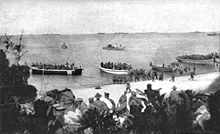
Out of loyalty to Great Britain sent Australia late 19th and early 20th century troops to South Africa ( Second Boer War ), as well as in both the First and in the Second World War troops to Europe, the Middle East and North Africa. In World War I, Australia had the highest number of dead of all allies relative to population. The defeat of the Australian and New Zealand Army Corps ( ANZAC ) in the country's first military operation at the Battle of Gallipoli in 1915 is considered by many Australians to be the birth of the nation. The soldiers who had returned from World War I built the Great Ocean Road as part of a job creation program .
With the Statute of Westminster of 1931, the Dominions of the Empire were formally given independence. The Australian parliament only approved this in 1942. The attempt at secession of Western Australia from 1933 failed.
By the end of the war in 1945, nearly a million Australians were serving in the Australian armed forces , mainly in mainland Europe, Africa and the Pacific War.
After the British defeat in Asia in 1942 and the impending Japanese invasion, military activities shifted from Europe to the Australian continent in 1942 to defend their own north coast. Australia increasingly turned to the USA as a new strong ally. This was formalized in 1951 with the ANZUS agreement.
After the Second World War, a progressive immigration policy was pursued, which led to mass immigration from Europe, and after the abandonment of the racist immigration policy ( White Australia policy ) also from Asia and other parts of the world. In a short time this led to strong demographic changes, but also to an economic upturn.
Australia took an active part in the Vietnam War and dispatched around 47,000 soldiers.
The Aboriginal civil rights movement began to grow in the 1960s, and in 1965 Queensland was the last state to grant them the right to vote. In addition, the land rights movement, which tried to return the land to its traditional owners, grew stronger. The Aboriginal Land Rights (Northern Territory) Act 1976 and in particular the judgment on Mabo v. Queensland (No. 2) (1992), which rejected the concept of Terra Nullius .
In the constitutional crisis of 1975 , a majority from the Liberal Party of Australia and the National Party of Australia in the Australian Senate tried to urge Prime Minister Gough Whitlam to elect the Australian House of Representatives . They postponed the vote for funding for government spending. Prime Minister Whitlam rejected these demands several times. As the situation deteriorated, the Governor General of Australia John Kerr dismissed the government on November 11, 1975 and appointed Malcolm Fraser as the new Prime Minister. After the parliamentary elections on December 10, 1977 and October 18, 1980, Fraser remained in office. In the elections on March 5, 1983, the Australian Labor Party recorded a landslide victory; Bob Hawke became the new Prime Minister and remained so until December 20, 1991.
In 1986, with the Australia Act , Great Britain gave up the final powers over the Australian Constitution . On November 6, 1999, 55 percent of voters voted against the creation of a republic in a referendum . Australia is still formally a parliamentary monarchy under Elizabeth II.
Developments in the 21st Century
In 2001, a ten percent consumption tax was introduced on all goods and services , the Goods and Services Tax (GST). It was supposed to replace many small taxes.
In 2004, the national-liberal coalition government of Prime Minister John Howard , who, as a supporter of the Iraq war , as an opponent of climate protection measures such as the Kyoto Protocol , strongly polarized society through a restrictive immigration policy (including the establishment of assembly camps on Nauru ) and forced social cuts, won again the parliamentary elections. The general economic conditions were comparatively good.
In December 2005, the Cronulla Riots broke out in a suburb of Sydney to racially motivated riots between white and Lebanese Australians.
In the fall of 2007, John Howard's administration lost the general election and Kevin Rudd became Prime Minister of a Labor government. The new government announced a new direction in social and environmental policy, relied on increased cooperation with the Pacific neighbors and for the first time officially apologized to the Aborigines for the injustice inflicted on them by white Australians, which Howard had always refused.
Origin of the Australians
| Ethnic group | 1787 | 1846 | 1861 | 1890 | 1947 | 1988 |
|---|---|---|---|---|---|---|
| native people | 100% | 42.5% | 13.3% | 3.4% | 0.8% | 1.0% |
| British and Irish | - | 57.2% | 78.1% | 86.8% | 89.7% | 74.6% |
| Other Europeans | - | 1.1% | 5.4% | 7.2% | 8.6% | 19.3% |
| Asians | - | 0.3% | 3.1% | 2.3% | 0.8% | 4.6% |
| Other | - | - | 0.1% | 0.3% | 0.1% | 0.5% |
literature
- J. Allen, J. Golson, R. Jones (Eds.): Sunda and Sahul: prehistoric studies in Southeast Asia, Melanesia and Australia. Academic Press, London 1977.
- Geoffrey Blainey: Triumph of the Nomads. A History of Ancient Australia. Macmillan, London 1976, ISBN 0-333-17583-2 .
- Stuart Macintyre: A Concise History of Australia. Cambridge University Press, 2004.
- Daniel Marc Segesser: Empire and total war. Australia 1905–1918 (= War in History, Vol. 10). Schöningh Verlag, Paderborn 2002, ISBN 3-506-74480-1 ( online ).
- Johannes H. Voigt : History of Australia and Oceania. An introduction. Böhlau, Cologne 2011, ISBN 978-3-8252-3388-4 . ( Review )
Web links
- Documenting a Democracy. In: Museum of Australian Democracy at Old Parliament House, subpage: Democracy . Museum of Australian Democracy at Old Parliament House in association with the National Archives of Australia , 2011, accessed January 12, 2017 (Presents 110 key documents that form the foundation of the Australian nation).
- The history of Australia (tabular)
- From Terra Australis to Australia , State Library of New South Wales
Remarks
- ↑ James F. O'Connell, Jim Allen, Martin AJ Williams et al .: When did Homo sapiens first reach Southeast Asia and Sahul? In: PNAS . Online advance publication of August 6, 2018, doi: 10.1073 / pnas.1808385115 .
- ↑ Ray Tobler1, Adam Rohrlach, Julien Soubrier, Pere Bover, Bastien Llamas, Jonathan Tuke, Nigel Bean, Ali Abdullah-Highfold, Shane Agius, Amy O'Donoghue, Isabel O'Loughlin, Peter Sutton, Fran Zilio, Keryn Walshe, Alan N. Williams, Chris SM Turney, Matthew Williams, Stephen M. Richards, Robert J. Mitchell, Emma Kowal, John R. Stephen, Lesley Williams, Wolfgang Haak, Alan Cooper: Aboriginal mitogenomes reveal 50,000 years of regionalism in Australia. In: Nature . March 8, 2017. For a condensed overview, see Aboriginal hair shows 50,000 years connection to country , University of Adelaide website .
- ↑ Jim Allen, Jack Golson, Rhys Jones (Eds.): Sunda and Sahul . Academic Press, London 1977.
- ^ J. Balme, Excavations revealing 40,000 years of occupation at Mimbi Caves in south central Kimberley of Western Australia. Australian Archeology 51, 2000, 1-5.
- ^ The Guardian: It could change everything ': coin found off northern Australia may be from pre-1400 Africa , May 11, 2019 , accessed May 15, 2019.
- ↑ http://southseas.nla.gov.au/journals/banks/17700428.html
- ↑ www.awm.gov.au: Vietnam
- ↑ 6,410,787 valid votes against and 5,273,024 in favor.
